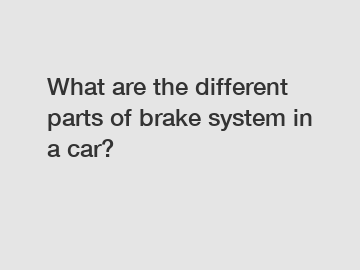Jan. 29, 2024
Transportation
What are the different parts of a brake system in a car and how do they work together to ensure your safety on the road?
The brake system is one of the most crucial components of any vehicle as it provides the means to slow down or stop when necessary. Understanding the different parts of a brake system is essential for every car owner in order to maintain their vehicle's optimal performance and ensure their safety on the road. In this article, we will explore the various components that make up a typical brake system and how they work together seamlessly.
1. Brake Pedal:

The brake pedal is the part of the brake system that the driver uses to initiate the stopping or slowing down of their vehicle. When you press the brake pedal, it transmits the force you exert to the master cylinder.
2. Master Cylinder:
The master cylinder is a crucial part of the brake system as it converts the force applied by the brake pedal into hydraulic pressure. It consists of a cylinder with pistons and seals that allow it to create hydraulic pressure when the brake pedal is depressed.
3. Brake Lines:
Brake lines are the channels through which the hydraulic fluid is transmitted from the master cylinder to the brake calipers or wheel cylinders. They are usually made of steel and are designed to withstand high pressures and resist corrosion.
4. Brake Calipers and Wheel Cylinders:
Brake calipers are used in disc brake systems, while wheel cylinders are employed in drum brake systems. These components house pistons that push the brake pads or shoes against the brake rotors or drums, generating the friction necessary to slow down or stop the vehicle.
5. Brake Rotors and Drums:
Brake rotors are part of the disc brake system and are attached to the wheels. When the brake calipers squeeze the brake pads against the rotors, the resulting friction causes the wheels to slow down or stop. In drum brake systems, the brake drums are attached to the wheels and provide the surface against which the brake shoes press.
6. Brake Pads and Shoes:
Brake pads are used in disc brake systems, while brake shoes are part of drum brake systems. These friction materials are designed to withstand high temperatures and generate the necessary friction to slow down or stop the vehicle. Over time, brake pads and shoes wear out and need to be replaced.
7. Brake Fluid:
Brake fluid plays a crucial role in the brake system as it transfers the hydraulic pressure generated by the master cylinder to the brake calipers or wheel cylinders. It should be regularly checked and replaced as it can become contaminated or degraded over time.
8. Brake Boosters:
Brake boosters, also known as power boosters, assist the driver in applying the necessary force to the brake pedal. They use vacuum pressure from the engine intake manifold to amplify the force applied by the driver, making it easier to stop the vehicle.
In conclusion, understanding the different parts of a brake system and how they work together is vital for maintaining the performance and safety of your vehicle. From the brake pedal to the brake calipers or wheel cylinders, each component plays a crucial role in ensuring efficient braking. Regular inspections, maintenance, and timely replacement of worn or damaged parts are essential for a well-functioning brake system. Remember, a properly functioning brake system can be the difference between a safe journey and a potentially disastrous accident. So, take care of your brake system – your safety and that of others on the road depend on it.
For more information, please visit China Brake Shoes Manufacturer, semi metallic brake pad supplier, China Reliable Manufacturer of Brake Shoes.
Previous: What is the alternative of CNG?
Next: The Ultimate Guide to Brake Parts: Everything You Need to Know
If you are interested in sending in a Guest Blogger Submission,welcome to write for us!
All Comments ( 0 )